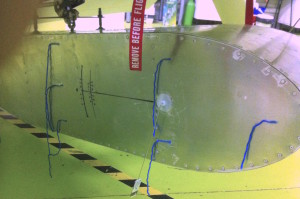flying the belly tank
Many news so far…
I am glad to inform that the Spanish Air Force has informed Skypolaris that they do confirm all the support they granted more than two years ago. It is very nice, because now it is time to have all the survival gear readied.
I hope that I will find enough room in the aircraft for it.
The truth is that my personal belongings will be scarce, and that after a few days, I will look Robinson Crusoe. I am still deciding about the ..underwear…
Soon there will be a meeting with the Polar Committee. Problem is that we cannot find a day that is ok for all the involved persons. Skypolaris will bring Mr. Alados (the Director of the scientific project) and the President of the National Aeroclub and myself.
The ¨admiral¨is now requiring more and more things. Some can be provided, others cannot ( for example, an insurance covering the retrieval of the airplane, if I crashland somewhere in Antarctica). He is requesting items that have not been requested to other polar expeditions.
Today I have test flown the belly tank.
What can I say?
Well…I feel really satisfied. No vibrations, no special aircraft behaving, no noise, nothing.
I did explore the envelope from stopped to 160 its indicated. The airflow in really similar along the full test.
First I flew at 80 kts. Then I did land and check everything, including the video footage of the belly tank and ¨sensors¨.
Then, later, I took off again and accelerated to 120 kts, then to 140 kts and finally to 160 kias.
After landing, the video footage showed everything nice, so I am quite satisfied.
Stall speed increased 3 kts (at 5000 ft) and when cruising at 55% engine power, I got 129 kias instead of the no tank speed of 135 kias. So we are talking about a 6 kts decrease, that seems very consistent with what <i did expect.
Also the Garmin 430 database has been updated. It was quite expensive, because I had to buy two 8 mb cards to hold the whole world data. In 2001, a 6 mb card was enough for it.
I tried Jeppesen to sponsor the software, as they did in 1998 and 2001, but now their boss is Boeing, and they declined the support. So…finally, I had to buy it.
Also I have bought all the Satcom items I need (sim card, grib files reader, email, sms, emergency and best of all, tracking). So, we will be able to communicate and also, you will be able to follow the flight progress.
Also FTE Jerez, flight training School, will host my stay when overnighting there, before the flight into Dakar. When loaded, I prefer to take off from long runway at sea level. It is just a safety item.
Jon Johanson, three times Australian Earthrounder, was very kind with me when I called him.
He told me that at full weight, his RV4 took 17 seconds for take off run. So 2300 ft will be fine and my decision to use 5000 ft runways lengths as minimum, will be conservative.
In the belly tank picture, you will see some wool lengths and also a floating vane. There is a degrees scale to see the relative airflow at the vane, and also along the fuel tank.
The flow pattern is funny, and consistent also with the bulky design of this fuel tank.
So…still going on !

Me alegra mucho informar que el Ejército del Aire Español, ha reconfirmado su apoyo al proyecto Cielo Polar. La primera confirmación tiene ya dos años, y gracias a él, podré disponer d todo el equipo de supervivencia que me falta. Ya es hora de ver como encaja en los escasos huecos libres del avión y para ello, espero disponer de ellos en breve.
De hecho, queda poco espacio, así que tendré que valorar incluso cuanta ropa interior llevaré (eso si, aunque los tengas me tientan por peso, creo que aun no estoy psicológicamente preparado para ponerme uno!).
En breve habrá una reunión con el Comité Polar Español. Su Secretario, el Almirante, cada vez pide más cosas, y las hay que se puede aportar y otras que no, como sucede con un seguro que nos pide, de recogida del avión, en caso de un aterrizaje forzoso en la Antártida. De hecho, aparentemente, ese es un requerimiento que no ha hecho a expediciones polares anteriores.
Por nuestra parte irá Lucas Alados (el Director del proyecto científico), Jose Luis Olías ( Presidente del Real Aeroclub de España) y el que suscribe.
Hoy he probado el depósito exterior en vuelo.
La verdad es que he quedado muy satisfecho de los resultados.
En toda la envolvente probada (de cero a 300 km/h), no ha habido vibración alguna, ni ruidos, ni comportamiento extraño del avión.
El flujo del aire alrededor del depósito fue muy similar entre los 150 y los 300 km/h). Eso si, resulta algo curioso en distribución, aunque racional.
Durante el primer vuelo, mantuve 150 km/h, y aterricé para comprobar que todo iba bien. La grabación de video también confirmó lo anterior, así que en el segundo vuelo, exploré los 225 km/h, los 260 km/h y los 300 km/h. Todas esas velocidades son indicadas.
La velocidad de pérdida aumentó 6 km/h a 5000 pies.
La velocidad a 55% de potencia bajó de 250 km/h a 240 km/h. El aumento de resistencia es correcto y dentro de lo esperado.
En otras palabras, estoy contento con estos resultados.
Por otro lado, ya he puesto al día la base de datos de navegación de mi Garmin 430. Ha sido un buen palo económico, ya que además de la propia base de cobertura mundial, he tenido que comprar dos tarjetas de 8 mb, para que quepan en ellas ( en 2001, una tarjeta de 6 mb lo cubría todo).
Evidentemente son tarjetas especiales.
Jeppesen ha pasado a ser filial de Boeing. La política de patrocinios de Boeing es diferente y no han seguido la línea anterior donde Jeppesen me patrocinó el software en 1998 y 2001).
En fin… a pagar!
También he comprado todo lo necesario para la comunicación vía satélite, y ahora podré mandar en vuelo, sms, correos, llamar, recibir ficheros Grib, y lo importante, podréis seguir en un mapa digital, el vuelo en tiempo real.
La Escuela de Formación de Pilotos FTE Jerez, prestará su apoyo durante mi estancia en Jerez, para volar hacia Dakar (o Saint Louis). Es buena noticia porque la Escuela cuenta con instalaciones donde dormir a pie de aparcamiento.
He decidido despegar desde Jerez, como política de usar pistas largas y a nivel del mar, cuando despego con grandes pesos.
El otro día hablé con Jon Johanson. Jon ha dado tres vueltas al Mundo con su RV4 y fue muy amable al atenderme.
Me comentó que a plena carga, su RV tardaba 17 segundos en despegar.
Eso corresponde a unos 700 metros, así que mi decisión inicial de usar pistas de una longitud mínima de 1500 metros, es conservadora.
En la foto adjunta, se puede ver los hilos de lana en el depósito, y una veleta que funciona como indicador de ángulo de ataque. Como había comentado, el flujo del aire alrededor del depósito resulta curioso, pero es coherente con su forma e interferencias.
Como podéis apreciar, seguimos avanzando !









One Comment
Excellent Post, Michel. You are making progress fast and we appreciate the information about the belly tank. A 6 knot decrease in speed is not too much, but fuel burn will increase too!
You must be logged in to post a comment.